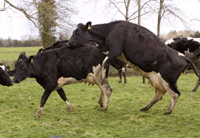Vet Watch – Treating ovarian cysts in cattle

By Steve Glanville, Hook Norton Veterinary Surgeons, Banbury
We have all heard it at our fertility routine “she’s not in calf because she’s got a cyst on her ovary” or “the reason you’ve not seen this cow bulling is a cyst on her ovary”.
So why do cows get cysts and what can we do about them?
The simple answer is, we don’t know exactly why some cows get cysts, but we do know the kind of circumstances in which they occur.
Predisposing causes include:
1) Genetic tendency towards cysts in certain family lines, especially high yielding Holsteins
2) Nutritional factors, in particular a negative energy balance, or high protein in feed
3) Social factors, such as mixing of heifers into the herd
4) Environmental, such as lameness
5) Trace element deficiencies
6) Seasonal influences, ie, worse in winter
7) Uterine factors, eg, Pyometra (whites).
A cyst is defined as a structure on the ovary, luteal or follicular, with a diameter of greater than 2.5cm.
The detection of a cyst means something has affected the delicate balance between the pituitary gland and hypothalamus in the brain which produce Gonadorelin releasing hormone (GnRH) as well as follicle stimulating hormone (FSH) and lutenising hormone (LH) and the ovary where the cysts are found.
Treatment
Treatments depends on the type of cyst. There are two types; the follicular cyst which is fluid filled and can be bigger than a squash ball, or a luteal cyst which is solid and more uniform in structure.
Luteal cysts usually respond well to a dose of prostaglandin, such as Estrumate or Lutalyse and the cow should come bulling five to seven days later; when not it is worth getting the cow checked again at the next routine.
Follicular cysts can be more problematic and different vets will have different approaches depending on their knowledge of the farm and what works best in their experience. One thing for certain is doing nothing is not an option.
A progesterone device (PRID/CIDR) is one treatment method and works by starving the cysts and stopping behavioural signs. This is inserted for 12 days and after removal the cow is served when seen bulling. Other treatments include administering an injection of GnRH at double dose and checking the cyst has lutenised two weeks later. Alternatively a combination of a progesterone device and GnRH can be used.
Occasionally, persistent cysts can be drained, but this is a sophisticated procedure.
It is important to follow up any treatment protocol with a scan of the ovaries to check the treatment has worked. The luteal cyst should have gone and the cow come into season. A follicular cyst should have lutenised and may start to cycle normally, either naturally or with a dose of prostaglandin.
Many farmers may have noticed, in recent years, an increase in the twinning rate of their cows. For this to occur a cow needs to produce and mature two follicles and release at least two eggs to be fertilised after ovulation.
Whatever the reason for this increase there are similarities with the development of persistent follicles which may develop into follicular cysts. So it’s possible the delicate balance between the brain and the ovary is having many influences on it, many of which we do not understand fully.
- XLVets is a group of farm animal-committed vet practices that work together, alongside commercial research and manufacturing companies. They aim to share best practice on advice and disease-prevention initiatives.
